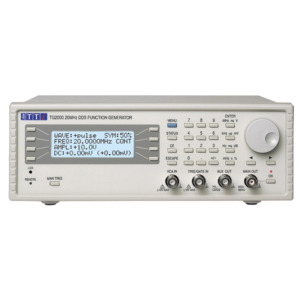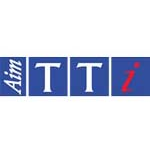
- Description
- Specifications
20MHz DDS Function Generator, RS232/USB
- TG2000 20MHz DDS Function Generator
- 0.001Hz to 20MHz frequency range
- 6 digits or 1mHz resolution
- 1ppm stability and 10ppm one year accuracy
- Low distortion, high spectral purity sine waves
- Internal phase continuous sweep, lin or log
- AM, FSK, gated and tone switching modes
- 5mV to 20V pk-pk from 50 or 600 Ohms
- Storage for multiple instrument set-ups
- USB and RS232 Interfaces
A new price point
The TG1000/2000 breaks new ground by offering a high quality DDS function generator at a significantly lower price. DDS (direct digital synthesis) is a technique for generating waveforms digitally using a phase accumulator, a look-up table and a DAC. The accuracy and stability of the resulting waveforms is related to that of the crystal master clock. When correctly engineered, the DDS generator offers not only exceptional accuracy and stability but also high spectral purity, low phase noise and excellent frequency agility.
Total digital control
Unlike some other generators which only provide digital control of frequency, every function is digitally controlled enabling complete instrument set-ups to be stored, or full remote control to be implemented (TG2000 only).
Wide frequency and amplitude range
The TG2000 can generate waveforms between 0.001Hz and 20MHz with a resolution of six digits and a one year accuracy better than 10ppm. The TG1000 has a 10MHz limit. Amplitude is variable between 5mV and 20V pk-pk from a source impedance of 50 Ω or 600 Ω. Unlike many generators, the waveform quality remains excellent over the full amplitude range.
RS-232 and USB interfaces
The TG2000 also includes both an RS-232 interface and USB interface. These interfaces can be used for remote control of all of the instrument functions and for remotely storing instrument set-ups.
Ease of use
The TG1000 and TG2000 are particularly easy to use. All of the main information is clearly displayed on a backlit LCD with 4 rows of 20 characters. Sub menus are used for the modulation modes and other complex functions.
All parameters can be entered directly from the numeric keypad. Alternatively most parameters can be incremented or decremented using the rotary encoder for quasi-analogue control.
Frequency or period entry
The generator frequency can be set in terms of either frequency or period. Numeric entry is floating point using whatever units the operator prefers.
Flexible amplitude entry
Amplitudes can be entered in terms of peak to peak voltage, RMS voltage or dBm. The output impedance can be set to 50 Ω or 600 Ω, and the amplitude can be set in terms of either the voltage into the correct termination, or the source EMF (for a high impedance load).
Quick recall of settings
Both generators provide nine memories for storing settings.
Because all parameters are controlled electronically, the memories store the full set-up of the instrument and automated test sequences are easy to set up. In addition to the nine user memories, the current state of the instrument is saved at switch off. The user can choose to have this state restored at switch on, or choose a pre-defined default set-up.
Synchronization The auxiliary output socket can provide any one of three different Sync. signals. Waveform Sync is a 50% duty cycle square wave at the frequency of the main output. Sweep Sync. outputs a pulse at the start of each sweep and can also output a pulse at a user defined marker frequency. Trigger Out provides a replica of the trigger signal which can be from the trigger input socket, the internal trigger/gate generator, the manual trigger key, or the bus interface.
